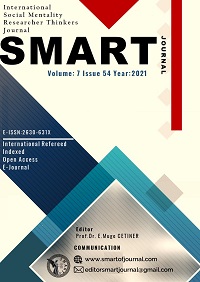THE CULTURAL REFERENCES IN TRANSLATION STUDIES AND METHODOLOGICAL APPROACHES IN THE PRATIQUE OF TRANSLATION
Author :
Abstract
This article focuses on the cultural dimension of translation and its effects on the pratique of translation. In modern Translation Studies translation is viewed as a process of cultural intermediation, an attitude that has brought forward the examination of the translation phenomenon in its cultural framework besides its linguistic one, taking into account a series of other factors related to the pratique of translation such as the cultural, social and political parameters. First of all, we will refer to early theoretical works in the field of Translation Studies that indirectly bear the cultural element such as Vinay & Darbelnet’s approach (1958). Then, we will describe the development of the so-called “Cultural Turn” in Translation Studies and its basic characteristics. Afterwards, we will describe the methodological approaches as well as the techniques that are proposed by theoreticians for the translation and transference of the cultural references of the ST (Source Text) to the target readership. Finally, we will briefly mention some models of categorization of the cultural elements of a text that translators could take into account in the practice of translation. The overall purpose of the research is to sensitize future translators toward the cultural dimension of translation and propose some methodological approaches that would help them develop their creativity in order to handle effectively translation difficulties owing to cultural differences between the Source and the Target text.
Keywords
Abstract
This article focuses on the cultural dimension of translation and its effects on the pratique of translation. In modern Translation Studies translation is viewed as a process of cultural intermediation, an attitude that has brought forward the examination of the translation phenomenon in its cultural framework besides its linguistic one, taking into account a series of other factors related to the pratique of translation such as the cultural, social and political parameters. First of all, we will refer to early theoretical works in the field of Translation Studies that indirectly bear the cultural element such as Vinay & Darbelnet’s approach (1958). Then, we will describe the development of the so-called “Cultural Turn” in Translation Studies and its basic characteristics. Afterwards, we will describe the methodological approaches as well as the techniques that are proposed by theoreticians for the translation and transference of the cultural references of the ST (Source Text) to the target readership. Finally, we will briefly mention some models of categorization of the cultural elements of a text that translators could take into account in the practice of translation. The overall purpose of the research is to sensitize future translators toward the cultural dimension of translation and propose some methodological approaches that would help them develop their creativity in order to handle effectively translation difficulties owing to cultural differences between the Source and the Target text.
Keywords
- Austin, John L. (1962). How to Do Things with Words. Oxford: Clarendon.
- Austin, John L. (1962). How to Do Things with Words. Oxford: Clarendon.
- Barthes, Roland (1977). Image, Music, Text (µετάφραση. Heath, S.). New York: Hill and Wang.
- Bassnett, Susan & André Lefevere (1990). Translation, History and Culture. London & New York: Pinter Publishers.
- Derrida, Jacques (1978). Positions (µετάφραση Bass, A.). Chicago: Chicago Univerity Press.
- Harvey, Malcolm (2003). A Beginner’s Course in Legal Translation: the Case of Culture-bound Terms.
- Holz-Mänttäri, Justa (1984). Translatorisches Handeln: Theorie und Methode. Helsinki: Suomalainen Tiedeakatemia.
- Katan, David (1999). Translating Cultures: An Introduction for Translators, Interpreters and Mediators. Manchester: St. Jerome.
- Newmark, Peter (1988). A Textbook of Translation. London: Prentice Hall.0Nida, Eugene (1964). Toward a Science of Translating. Leiden: E. J. Brill.
- Reiss, Katharina (1977/2002). La critique des traductions, ses possibilitiés et ses limites. Traduit de l’allemand par C. Bocquet. Artois: Presses Universités.
- Searle, John (1969). Speech Acts. Cambridge: Cambridge University Press.
- Snell-Hornby, Mary (1997). Translation Studies: An integrated approach. Amsterdam & Philadelphia: Benjamins
- Steiner, George (1975). After Babel. Aspects of Language and Translation. Oxford: Oxford University Press Triverdi, Harish (2005). “Translating Culture vs Cultural translation”, 91st Meridian.org.
- Venuti, Laurence (1995). The Translator’s Invisibility: A History of Translation. London: Routledge.
- Vermeer, Hans (1998). “Didactics of translation”, in M. Baker (Ed.), Routledge Encyclopedia of Translation Studies. London: Routledge. 60-63.
- Vinay, Jean Paul & Darbelnet, Jean (1958). Stylistique Comparée du Francais et de l’Anglais: Méthode de Traduction. Paris: Didier.
- Wolf, Michaela (2000). The Third Space in Postcolonial Representation, in S. Simon & P. St-Pierre (eds),Changing the Terms: Translating in the Postcolonial Era. Ottawa: University of Ottawa Press. (pp.127-146)





